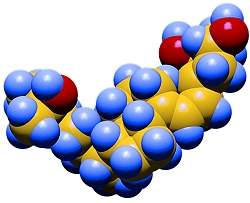 |
| Quanto menores os níveis de vitamina D, mais baixos os níveis de hemoglobina no sangue e mais elevado é o risco de anemia. |
Uma nova pesquisa destaca a relação entre carência de vitamina D e anemia em crianças.
O excesso de cuidado na exposição das crianças ao Sol, provavelmente motivadas pelos alertas contra o câncer de pele, tem levado a níveis insuficientes de vitamina D entre crianças e jovens.
O novo trabalho foi apresentado no domingo (1º/5), por cientistas do Centro Infantil Johns Hopkins e de outras instituições durante a reunião anual das Sociedades Acadêmicas Pediátricas dos Estados Unidos, em Denver.
Vitamina D e anemia
A anemia é diagnosticada e acompanhada pela medição nos níveis de hemoglobina no paciente. Para investigar a relação entre hemoglobina e vitamina D, os pesquisadores analisaram dados de amostras de sangue de mais de 9,4 mil crianças de 2 a 18 anos.
Segundo o estudo de Meredith Atkinson e colegas, quanto menores os níveis de vitamina D, mais baixos os de hemoglobina e mais elevado é o risco de anemia.
Crianças com níveis de vitamina inferiores a 20 nanogramas por mililitro (ng/ml) de sangue apresentaram risco 50% maior de contrair anemia do que as com níveis mais elevados.
Para cada 1 ng/ml a mais da vitamina, o risco de anemia caiu 3%. O estudo indicou que apenas 1% das crianças brancas avaliadas tinha anemia, contra 9% das negras.
Essas últimas apresentaram, em média, níveis inferiores (18 ng/ml) da vitamina do que as primeiras (27 ng/ml).
Fatores genéticos e biológicos
Estudos anteriores já haviam destacado que a anemia é mais comum em crianças negras, mas os motivos para a diferença permanecem desconhecidos.
O novo estudo indica que, além de fatores biológicos e genéticos, o nível de vitamina D deve ser levado em conta na manifestação da anemia.
Os pesquisadores ressaltam que, embora os resultados do estudo apontem uma clara relação entre níveis da vitamina D e anemia, eles não devem ser usados para estabelecer uma condição de causa e efeito.
Isto é, os resultados mostram que insuficiência de vitamina D e anemia ocorrem juntas, mas não são conclusivos de que a deficiência de vitamina D seja a causa da anemia.
Importância da vitamina D
Estudos recorrentes têm mostrado uma importância cada vez maior da vitamina D em diversos processos biológicos:
- Falta de vitamina D pode prejudicar o coração
- Deficiência de vitamina D aumenta risco de gripe
- Deficiência de vitamina D aumenta risco de hipertensão em mulheres
- Vitamina D é essencial para ativar o sistema imunológico
- Deficiência de vitamina D é associada com declínio cognitivo
- Vitamina D diminui risco de Mal de Parkinson
- Vitamina D influencia mais de 200 genes
- Jovens brasileiros têm insuficiência de vitamina D
